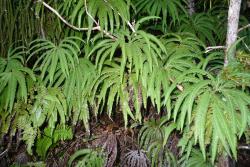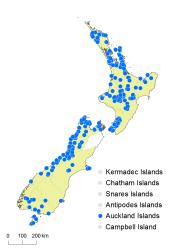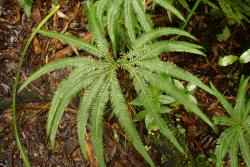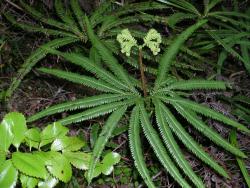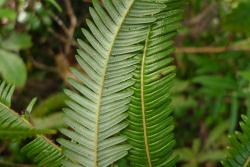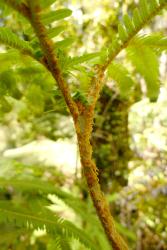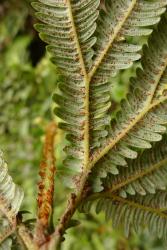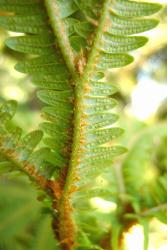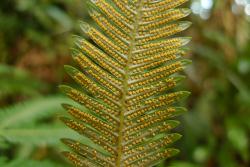- ≡ Gleichenia cunninghamii Heward ex Hook., Sp. Fil. 1, 6, t. 6b (1844) – as G. cunninghami
- = Gleichenia ciliata Colenso, Trans. & Proc. New Zealand Inst. 29: 414 (1897)
- ≡ Sticherus ciliatus (Colenso) Nakai, Bull. Natl. Sci. Mus. 29: 15 (1950)
- = Gleichenia cunninghamii var. montanum Dobbie, New Zealand Ferns ed. 3, 399 (1931)
Rhizomes long-creeping, 2–5 mm diameter; rhizome scales lanceate, 2.5–7.0 mm long, 0.5–1.0 mm wide, brown, shortly ciliate. Fronds 140–980 mm long. Stipes 65–730 mm long, scaly particularly distally, or glabrous. Laminae 70–450 mm long, 130–490 mm wide, adaxially green, abaxially usually glaucous (rarely ± green), coriaceous or herbaceous, scaly. Rachis buds not extending or extending once (rarely twice), scaly; usually pseudostipulate, with one usually lobed costal segment near base of each flanking branch. Rachis bud scales lanceate or ovate, 0.8–5.0 mm long, 0.2–1.6 mm wide, brown, ciliate. Pinnae 120–280 mm long, 75–400 mm wide; with 3 (rarely 2 or 4) successive pseudodichotomous forks (excluding growth from pinna buds); pinna buds not extending or rarely extending once or twice, sometimes absent. Proximal-most (primary) costae 5–20 mm long, with usually 0–2 (rarely 3) pairs of costal segments (excluding pseudostipules). β costae 8–80 (rarely to 120) mm long, with 3–20 (rarely to 39) pairs of costal segments. Ultimate leaflets narrowly ovate, 80–270 mm long, 9–34 mm wide, usually angustate (rarely caudate), usually mostly falcate; with 30–66 pairs of ultimate segments; pairs in centre of lamina diverging 30–55°. Abaxial surface of α costae scaly; scales lanceate or ovate, 1350–4000 µm long, 280–850 µm wide, brown, ciliate, persistent. Ultimate segments narrowly oblong, 5–20 mm long, 1–2.5 mm wide, arising at 55–70° from α costae, entire, acute; abaxial surface with persistent pale stellate scales that resemble branched hairs. Sori 3–17 either side of midvein, usually with 3–5 sporangia each. Spores 29–31 µm long, 14–15 µm wide (4 populations).
The abaxially glaucous ultimate segments and prominent scales on the abaxial surface of the α costae distinguish Sticherus cunninghamii from the other Sticherus species in New Zealand.
North Island: Northland, Auckland, Volcanic Plateau, Gisborne, Taranaki, Southern North Island.
South Island: Western Nelson, Sounds-Nelson, Westland, Canterbury, Otago, Fiordland, Southland.
Stewart Island, Auckland Islands.
Altitudinal range: 5–1370 m.
Sticherus cunninghamii is widespread from near Kaitaia in the North Island through to Stewart Island, and also occurs on the Auckland Islands. It occurs from near sea level to 1250 m above sea level in the North Island, 1370 m in north-west Nelson, and just over 1000 m elsewhere in the South Island. It is absent from large areas east of the axial ranges in both the North and South Islands.
Sticherus cunninghamii occurs in all major forest types, as well as in scrub. It extends rarely to subalpine grassland. It grows in the open or in shade, and while often found in drier sites like ridges and banks, it can also occur on wet ground.
Sticherus cunninghamii hybridises infrequently with all of the other Sticherus species in New Zealand. Hybrids can usually be recognised by their intermediate frond and scale characteristics and abnormally formed spores. Hybrids with S. tener and S. urceolatus were documented by Brownsey et al. (2013). Based on morphological intermediacy, hybrids between S. cunninghamii and S. flabellatus also occur, albeit infrequently (e.g., abaxially glaucous, but with caudate leaflets, and scales on the abaxial surface of the α costae of intermediate width): unlocalised, Colenso s.n., WELT P002888, P002890, P002891, P002897, P002905; Whangarei, A.J. Dakin s.n., AK 213848; Great Barrier Island, A.E. Wright s.n., AK 220418. The spores of WELT P002891 include a high proportion of irregular shapes, supporting the inference of hybridity.
n = 34 (Brownlie 1958).



